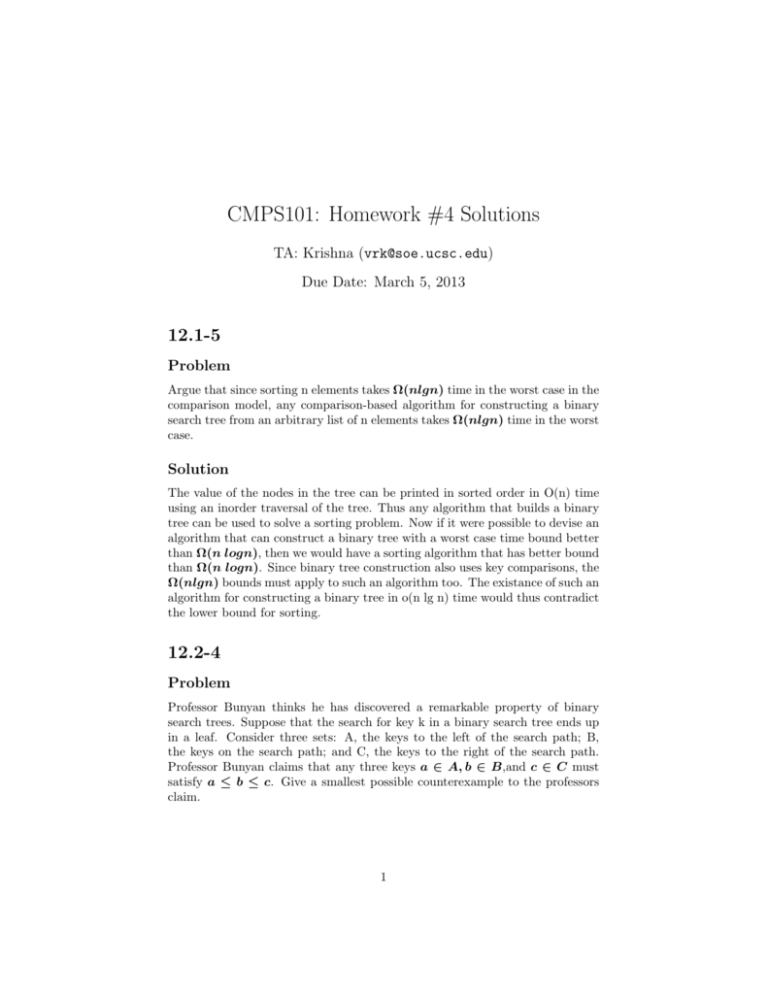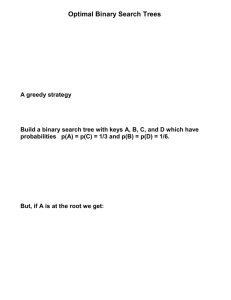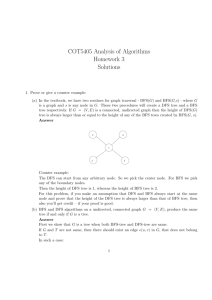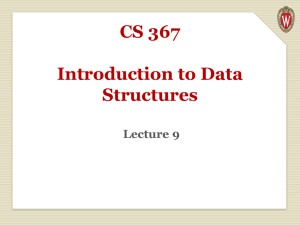CMPS101: Homework #4 Solutions
advertisement

CMPS101: Homework #4 Solutions
TA: Krishna (vrk@soe.ucsc.edu)
Due Date: March 5, 2013
12.1-5
Problem
Argue that since sorting n elements takes ⌦(nlgn) time in the worst case in the
comparison model, any comparison-based algorithm for constructing a binary
search tree from an arbitrary list of n elements takes ⌦(nlgn) time in the worst
case.
Solution
The value of the nodes in the tree can be printed in sorted order in O(n) time
using an inorder traversal of the tree. Thus any algorithm that builds a binary
tree can be used to solve a sorting problem. Now if it were possible to devise an
algorithm that can construct a binary tree with a worst case time bound better
than ⌦(n logn), then we would have a sorting algorithm that has better bound
than ⌦(n logn). Since binary tree construction also uses key comparisons, the
⌦(nlgn) bounds must apply to such an algorithm too. The existance of such an
algorithm for constructing a binary tree in o(n lg n) time would thus contradict
the lower bound for sorting.
12.2-4
Problem
Professor Bunyan thinks he has discovered a remarkable property of binary
search trees. Suppose that the search for key k in a binary search tree ends up
in a leaf. Consider three sets: A, the keys to the left of the search path; B,
the keys on the search path; and C, the keys to the right of the search path.
Professor Bunyan claims that any three keys a 2 A, b 2 B,and c 2 C must
satisfy a b c. Give a smallest possible counterexample to the professors
claim.
1
Figure 1: Counter example to Professor Bunyan’s claim. The set A is empty.
The search path, where search is performed for the key 3 is marked. The search
proceeds from root 8 to the node 4 and then to node 3. So B = {8, 4, 3}. Set
C is the only key to the right of the path, i.e., C = {6}.
Solution
The claim is wrong. A simple counter example is shown in figure 1. In the
figure, the search is being done for leaf node 3, so the set B = {8, 4, 3}. There
is nothing to the left of the path and so set A = { }. Set C is all elements to
the right of the path, so set C = {6}. For any element a 2 A, and b 2 B the
claim is true, since A is an empty set. But if set b = 8 and c = 6, the claim
fails to hold.
12.3-3
Problem
We can sort a given set of n numbers by first building a binary search tree containing these numbers (using TREE-INSERT repeatedly to insert the numbers
one by one) and then printing the numbers by an inorder tree walk. What are
the worst-case and best-case running times for this sorting algorithm?
Solution
Tree-Sort(A)
// let T be an empty binary search tree
for i <- 1 to n
do Tree-Insert(T, A[i])
Inorder-Tree-Walk(root[T])
Worst case of ⇥(n2 ) occurs when a linear chain of nodes results from the
repeated insert operations. It can be easily verified that this follows from the
2
Figure 2: Example demonstrating that bst delete operation is not commutative.
following recurrence. T (n) = T (n 1) + cn, i.e., to insert n nodes, the cost
is T (n 1) (the cost of inserting n-1 nodes) and the cost of inserting the nth
node. Solving this recurrence, we get the ⇥(n2 ) as runtime cost.
Best case of ⇥(n lg n) occurs when a binary tree of height ⇥(lg n) results
from the insert operations. When inserting nth node, we are inserting it into a
tree with
Pnheight log(n) since the tree is perfectly balanced. Thus the runtime
cost is i=1 (lgi + d) = ⇥(nlgn).
12.3-4
Problem
Is the operation of deletion commutative in the sense that deleting x and then y
from a binary search tree leaves the same tree as deleting y and then x? Argue
why it is or give a counterexample.
Solution
The deletion is not a commutative operation. A counter example is shown in
the figure 2.
3
13.1-6
Problem
What is the largest possible number of internal nodes in a red-black tree with
black-height k? What is the smallest possible number?
Solution
Note that the black height bh(x) is defined as number of black nodes on any
path from node x to a leaf, not including x.
The smallest possible number of internal nodes is 2k 1, which occurs when
every node is black. This is produced by a complete binary tree with k levels
with all nodes black. This tree has 1 root at levelP
0, 2 internal nodes at level 1
k
so on. Adding up we get, total internal nodes = l=0 2l = 2k 1.
The largest possible number of internal nodes is 22k 1 which occurs when
every other node in each path is a black node. This is produced by a complete
binary tree which has alternating levels of black and red nodes. Since the black
height is k, the height of the tree is 2k. Using similar calculations as before, we
find that total number of internals nodes is 22k 1.
13.3-2
Problem
Show the red-black trees that result after successively inserting the keys 41; 38;
31; 12; 19; 8 into an initially empty red-black tree.
Solution
The resulting red-black trees are shown in the figure 3.
14.2-5
Problem
Given an element x in an n-node order-statistic tree and a natural number i,
how can we determine the ith successor of x in the linear order of the tree in
O(lgn) time?
Solution
This can be done easily using the OS-RANK() and OS-SELECT() methods
given in the text.
4
Figure 3: red-black trees that result after successively inserting the keys 41; 38;
31; 12; 19; 8
5
SUCCESSOR(T, x, i) {
rank = OS-RANK(T, x);
srank = rank + i;
Node t = OS-SELECT(T.root, s);
return t;
}
Since OS-RANK() and OS-SELECT() both have O(lg n) runtimes, SUCCESSOR() also takes O(lg n).
6




![Question#4 [25 points]](http://s3.studylib.net/store/data/007289590_1-57e227b5dac30eb17dd4115b9416253c-300x300.png)



